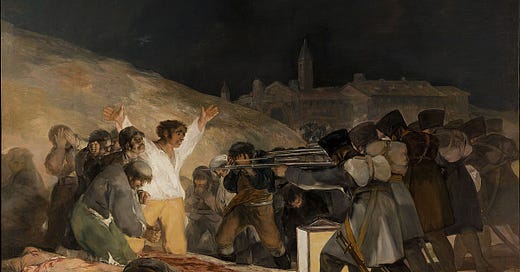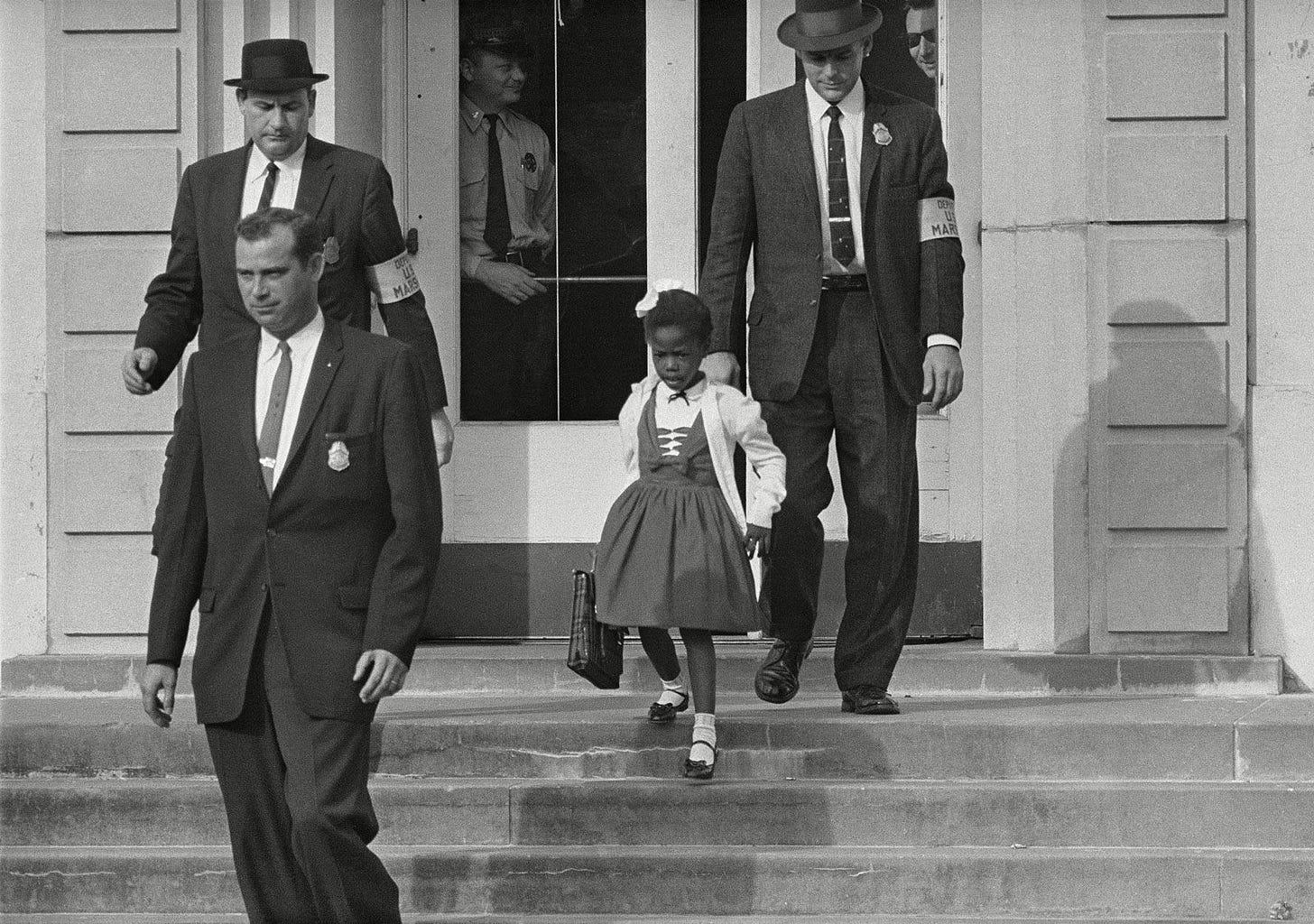In Goya’s 1814 ‘The Third of May, 1808’ the sense of fear is palpable, a symphony composed of cries and of gunfire that echoes into the night. Shadows crudely awakened by intrusive light, anonymity meets obscurity meets this blinding sense of fear.
And in the centre: a man.
He stands with arms outstretched and face contorted into a plea for his life as the bodies around him writhe in the final throes of death. Standing amongst them is this Christ-like figure seeking sympathy from both his killer and, more importantly, from the viewer.
This is Goya’s portrayal of the events that took place under the French occupation of Spain, with the occupants of Madrid depicted are presented as martyrs in the face of terrorism, as victims yet also fighters. And it is this careful portrayal that is our entry into this bridge between art and activism.
The premise of this entire newsletter is an exploration of art history and activism- how they connect, how they inform one another throughout time- so its a just, if a little late, idea to explore this connection fully.
Before I get into the post, I want to apologize for not writing anything the last few weeks, I’ve been focusing on researching for this one to make sure it is the finest it can possibly be. Also my free time has been filled with some very good, if very unrelated books, which I hope to do reviews of on here in due course.
Art and Activism
But first…
Art always has a purpose
Regardless if it’s not advocating a cause or igniting sympathy for its subject, or even if it’s not based in real life, art always has a purpose. Even the Aestheticism movement of the late Victorian period aimed to prove that art could simply be for aesthetic purposes rather than an active purpose. The paradoxical nature of this extends into how they’re trying to sway opinions and counter contemporary understandings.
Aestheticism occurred in the wake of Victorian realism, a genre which prioritized moral narratives and social reality above all else, aiming to depict it via an accurate if somewhat dramatized style. In lieu with the work ethic of Industrial times, progress was deemed the highest standard, whether that was artistic or social progress sparked by the art.
As with everything, there is a counter movement.
Aestheticism acted as a counter-cultural presence, rebelling against this need for progress into the future and instead drawing on the past. Above all they valued the artistic self, one separate from the social and political, one that contributed to art as a need for decoration. This decorative art was a tribute to their own values of languor where days could be passed in the pleasure reserved for the non-working upper classes, so very distant from the issues that plagued the streets far below them.
This, despite my language used, was not objectively bad and their art was not bereft of the social commentary that they were so aversed to. It was these artists that saw the threat of the Industrial Revolution on the cottage industries. Seeing how the Industrial Revolution- and, by extension, capitalism- had negative effects on the worker, uprooted individuality and prized the badly made over the expertly made. Capitalism’s ceaseless hunger for progress was rebelled against by these Aesthetic artists as they returned to the Medieval for inspiration, to the more simpler times. However one-dimensional this idea was, it opened a space for other fringe groups to form, specifically ones that went against Victorian ideals of morality- think of dandies like Oscar Wilde.
The Aesthetic movement did, overall, form these spaces for questioning to status quo as well as draw attention to social issues, but this activism through art:
Did it really help?
Art to Promote Causes
The Realism that Aestheticism fought against was also, or even more so, a form of activism.
Realist paintings depicted to the new urban world that had arisen from the Industrial Revolution with large amounts of people moving to the cities to find work. This led to numerous issues surrounding the overcrowded environments that these people had to live, eat and work in.
Depictions of the issues faced by these workers doing low-pay, long-shift jobs were called poverty portraits. They portrayed issues of sanitation, food shortage, education and poverty with the aim of pulling on the heart and purse strings of the wealthy visitors of fashionable galleries where these paintings were hung, with sympathetic results. Here, art acted as modern day marketing does: highlighting a problem, then raising money off of it, with perhaps better intentions than that of the corporate world.
These poverty portraits differed in their approach to their subjects, some lending a more idealized light on them whilst others aimed for the stark truth, But whether the artist conveyed picturesque poverty or pursued the bitter reality, there were universal motifs: shadows, under eyes or in the dark streets, and children as little beacons of sympathy.
Luke Fields’ 1874 ‘Applications for Admission to a Casual Ward’ appears to blend all of these together. Fields portrayal of a casual ward- where a night’s bed is given in exchange for a shift of manual labor- is wholly sympathetic to its variety of subjects. Yet at the foreground is the focus of the viewer, this mother and daughter couple walking to the back of the queue under the dim lamp that exposes their plight. The figures in the background are heavily veiled by the shadows that stretch across the piece, leaving only vague silhouettes to be determined by the viewer: a boy, a hatted man leaning against the wall, a child asleep in the arms of her father. Fields’ use of these silhouettes conveys to the viewer simple narratives that allow the figures to be completely interchangeable. Despite the characterization of the working class as this anonymous mass of interchangeable, powerless workers, this does work in the favour of garnering the sympathy of the painting’s upper-class viewers- they don’t pose a threat to them and instead just require sympathy and a financial contribution to the charity that sponsored the work. Through this, they can act as the savior.
In this way, these poverty portraits can be seen as useless in the face of the issues they aim to draw attention to. By not getting the root of the problem and instead focusing on the effects of the issues at hand, deeper systemic problems are simply glossed over. There was also this reliance on stereotypes and gentrified, swallowable images of poverty in order to appeal to the wealthy viewer that wiped out the individualism of a larger portion of the population- 2/3 to be exact.
However, these portraits do rebel against other more harmful stereotypes of the working class as vandals and criminals driven by the desire to suck the life out of the economy, rather than a result of their circumstances. This proves that activism in art had the power to change poeple’’ views, if not the issue itself.
Another Example…
A more modern day example is the photography used in the 20th century to draw attention to social issues that gripped those around the world, rather than just those in Britain. Photographers like Nick Ut and Steve McCurry aimed to highlight individual at the centre of these large-scale often distant issues in order to focus on the humane side of debates. These personal stories evoked sympathy in the viewer and, like poverty portraits, changed minds.
International issues like effects of the chemical weapon napalm are explored. Nick Ut’s ‘Napalm Girl’ is a prime example of photography being used to spread awareness about the harm of napalm in the Vietnam war. This photo was heavily circulated in sympathetic press, leading ultimately to the ending of this chemical weapon being used in the war. The reasons behind it can be seen in the common motifs of activism in art: the child at the centre, the vivid emotional impact of the piece and the harrowing narrative displayed clearly to the viewer.
Similar narratives are displayed in the photo of Ruby Bridges, the first student of school to enter after segregation laws were reversed. A similarly sympathetic response arises from the sight of such a small child surrounded by the tall, official figures of federal agents. Once again, this photo was crucial in changing people’s minds about desegregation in schools.
Emotional personal narratives that are underlined by social issues and popular topics of conversation leads back to Goya and his portrait of the French occupation of Spain.
What makes it so effective?
As we have seen throughout the examples included so far, a key part of what make art activism so effective is its emphasis on personal narratives. Goya’s painting is a testament to this.
Goya engages several techniques to draw the viewer’s eye towards the figure of central focus of the piece, highlighting his significant position in the piece’s narrative as the hero of the painting. His significance is emphasized via how all formulaic lines in the composition lead back to him: the guns, the rays of the light, the slope in the background. His pained expression of despair is exaggerated in contrast to the shadowed anonymity of the soldiers that threaten him. But most significantly, his white shirt contrasts to the darkness of the night around him also contributing to the martyr narrative that underpins his role in the narrative.
This role is crucial to the painting’s audience due to the figure’s resemblance to Christ, toying with the Catholic religion of Goya’s desired audience. Not only does the white of his shirt evoke imagery of the Bible’s sacrificial lamb but the pose he holds also has significant religious symbolism- his arms are outstretched like those of Jesus on the cross, imagery further highlighted via the faint stigmata on his hands.
Overall, Goya’s portrayal commemorates the struggle of everyday citizens under the occupation, highlighting specifically the unnamed martyrs of the cause, presenting art as activism for causes that would be lost.
But What does activism in art achieve?
The conclusion that I have come to is that activism in art itself does not achieve change. Not significant, long-lasting change anyway. But with its sympathetic powers and ability to highlight the unseen, thus engage the audience in the unsightly, it does succeed in changing opinions and that through enough changed opinions in the right places could be beneficial in getting to the root cause of the issue. And, if you’re to take anything from today’s post, know that all art has a purpose and, in this way, all art is activism.
Please feel free to comment about today’s essay, whether that be criticism (or praise, which I am also partial to) or further discussions of this topic perhaps linking to your understanding, world outlook and personal subject knowledge no matter your area of expertise.
Here, are some questions to consider:
Is all art activism?
Does art really change anything?
And,
What would art need to pull your heartstrings?
Further reading and a few materials used:
Currently reading: The Belles by Dhonielle Clayton and The Alphabet Versus the Goddess by Leonard Shlain (review coming soon!)
Random Recommendation: Sky Castle
Have a good day! (´▽`ʃ♡ƪ)









